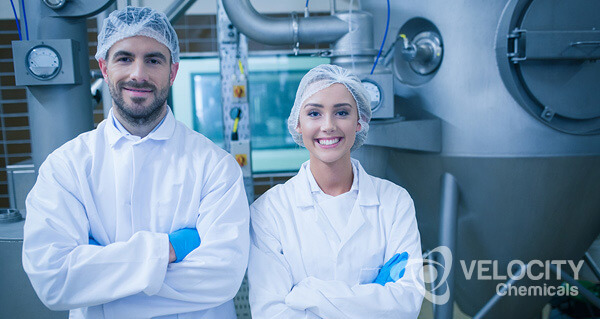Sanitizers and Disinfectants: Why Understanding The Difference Is Important
 Whether operating a food processing plant, or maintaining a dairy, livestock or arable farming operation, concern over levels of hygiene and cleanliness is always acute. Anywhere that food is processed or handled, the risk of contamination can be high if this single issue is not attended to properly. So, it stands to reason that your choice of chemical sanitizers and disinfectants is important.
But while many food processing and dairy farm chemicals are multi-purpose, it would be a mistake to assume that a sanitizer and a disinfectant are one and the same. There are some key differences that should be kept in mind, not least because a sanitization is not necessarily enough to ensure a fully disinfected surface.
Whether operating a food processing plant, or maintaining a dairy, livestock or arable farming operation, concern over levels of hygiene and cleanliness is always acute. Anywhere that food is processed or handled, the risk of contamination can be high if this single issue is not attended to properly. So, it stands to reason that your choice of chemical sanitizers and disinfectants is important.
But while many food processing and dairy farm chemicals are multi-purpose, it would be a mistake to assume that a sanitizer and a disinfectant are one and the same. There are some key differences that should be kept in mind, not least because a sanitization is not necessarily enough to ensure a fully disinfected surface.
Disinfecting Versus Sanitizing
On the face of it, both of these processes are the same. They are both designed to clean away microorganisms that can cause illness or otherwise affect the health or workers and consumers. In simple terms, the difference relates to the level of hygiene that is achieved – one removing the health threat completely; the other containing it to a safe level only.

Sanitizers
Many people believe this is a more thorough, severe level of cleaning, but in fact this is not so accurate. To sanitize means to reduce microorganisms of public health importance to levels considered safe. These levels are set by a relevant authority, based on established parameters but without adversely affecting the quality of the product or its safety. In Canada, the authority is the Bureau of Chemical Safety (BCS), under the auspices of Health Canada, while in the US, it’s the Food and Drug Authority (FDA).
According to a 2011 guide published by the National Collaborating Centre for Environmental Health (NCCEH), here are 2 types of sanitizers – food contact and non-food contact – and each have specific standards that they must meet to be acceptable. To do so, food contact sanitizers must:
… reduce microbial contamination of specific bacteria by 99.999% or 5 log in 30 seconds at 20°C. Food contact sanitizers with no disinfectant claims may only reduce bacteria by 99.9% within 5 minutes.With non-food contact sanitizers, approval is only granted if the sanitizers satisfy the standard that states:
… the chemical must reduce microbial contamination by 99.9% (3 log) or more within 5 minutes at room temperature (around 20-22°C).With sanitizers, getting the best results depends greatly on the state of the surface being attended to. Whether it is a bench where food preparation or processing takes place, or machinery coming in direct contact with food, the surface needs to be clear of organic materials (like proteins or fats) and residues. This generally means rinsing down the area and then cleaning it with a detergent before rinsing that off. Only then should the chemical sanitizer be applied.
Disinfecting
To disinfect relates to the destruction or irreversible inactivation of specified infectious microorganisms, including fungi and bacteria on hard surfaces. However, disinfecting does not necessarily include destroying or inactivating the spores of microorganisms.
The NCCEH adds that a disinfectant as an antimicrobial agent capable of destroying pathogenic and potentially pathogenic microorganisms, but if the chemical disinfectant does not have specific target organisms noted on the label, it’s considered a bactericide. It also clarifies that:
… disinfectants include bactericides, fungicides, virucides, mycobactericides, tuberculocides, sporicides, sterilants or any combinations thereof. There are various levels of disinfectants (low, intermediate, and high) categorized by differing efficacy levels, which in turn depend on their intended use. Efficacy of disinfectants is based on statistical significance of killing test bacteria on carriers.Effective disinfecting can take time, with as much as 10 minutes required depending on the microorganisms in question, especially where efforts are made to kill off spores. The concentration of the solutions can vary as a result, and getting this right is obviously critical to fully effective cleaning. Some products do combine the actions of sanitizers and disinfectants, but it is important that the details on the label are read carefully. Not all such products are suitable, and often the time needed to achieve a thorough sanitized clean varies.
Food Surface Sanitizers and Disinfectants From Velocity Chemical
Velocity Chemicals is an established name in formulating and manufacturing a chemical sanitizers and disinfectant for the food processing, farming and arable and fruit farming sectors. All of the products in our range are designed to provide the highest levels of cleaning effectiveness without impacting on the quality of food being handled or produced. And because we also customize formulas to meet specific needs, almost every situation can be catered to.
When it comes to sanitizing and disinfecting, the most suitable products in the Velocity Chemicals include:
VELOSAN – a Quaternary ammonium compound that is ideal for cleaning and sanitizing hard surfaces in food processing and industrial areas. CFIA approved, it’s an effective one-step sanitizer for non-food contact surfaces and food contact surfaces where a rinse is not required. It is a non-acid disinfectant with no phosphates, and a hard water and organic soil tolerance Cleans, disinfects, and deodorizes at the same time. VELOSAN is also recommended for use in hatcheries, poultry and swine premises to disinfect and clean equipment or heavy duty vehicles, and other hard surfaces.
For more information on the range of Velocity Chemical products, talk to one of the Velocity Chemicals team.
Tags: Disinfectants, Sanitizers




